A 150-kilometer-wide hollow on Mars named Gale Crater has emerged as the front-runner for the potential landing site for the Mars Science Laboratory rover, Curiosity, which will head to Mars this fall. Nature News and the Planetary Society Blog report that following a meeting of project scientists last month, Gale came out on top of four different locations as the preferred destination for the next Mars rover. However, the final decision has not been made or announced, and NASA Associate Administrator Ed Weiler has the final word. He is expected to make the final decision on Friday with a formal announcement of the site to follow next week.
[/caption]
According to planetary scientist Matt Golombek, who was part of the selection committee, Gale Crater has a high diversity of geologic materials with different compositions, created under different conditions. Most interesting is evidence of different minerals arranged in stratigraphical context. “Stratigraphy records multiple early Mars environments in sequential order,” Golombek said at a teleconference for Solar System Ambassadors and Solar System Educators earlier this year. “Gale is characteristic of a family of craters that were filled, buried and exhumed, and will provide insights into an important Martian process.”
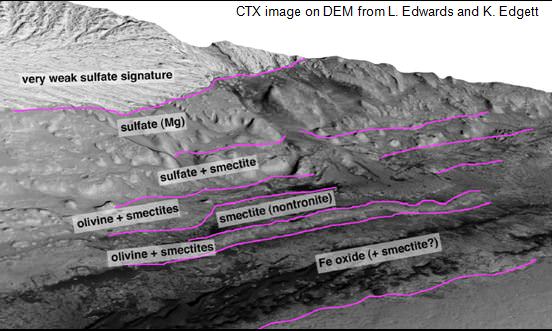
The actual landing ellipse is a smooth area with few craters, which is a great and safe place for landing. But the MSL rover – which is the size of a small car – could then take a few 100 sols and head out for more interesting terrain where the sedimentary strata is deposited. There’s a giant 5-kilometer high hill in the middle of the crater, and the rover could traverse up through the lower most layers.
The flythough video of Gale Crater, top, was put together by UnmannedSpaceflight‘s Doug Ellison, who used a mix of HRSC, CTX and HiRISE elevation models, combined with a pair of possible traverse paths for MSL.
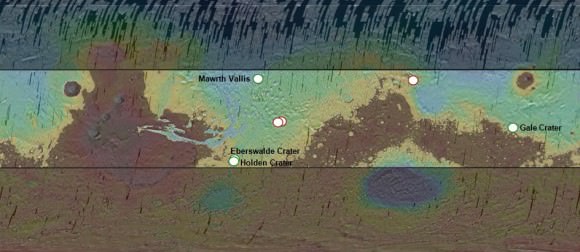
The three other choices also have their good points. All the different landing site choices lie between 30 degrees latitude north and 30 degrees south with low elevations – which is a good thing when trying to land on Mars, Golombek said, because that gives you more of Mars’ thin atmosphere to work with. “All the sites are scientifically rich and safe for landing, with small differences between them,” Golombek said.
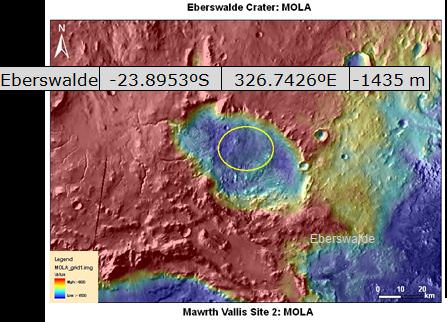
Eberswalde Crater has interesting, rough terrain with flow features that are “clear evidence for a river that entered into a standing body of water at sometime into the past on Mars,” Golombek said. “There’s not much disagreement in science community that this is a ancient delta on Mars.”
This region would provide geologic evidence for how the minerals were deposited and evidence for clay minerals.
“Clays are trappers and preservers of biogenic materials, so going to places where these minerals were deposited in calm water is very enticing,” Golombek said.
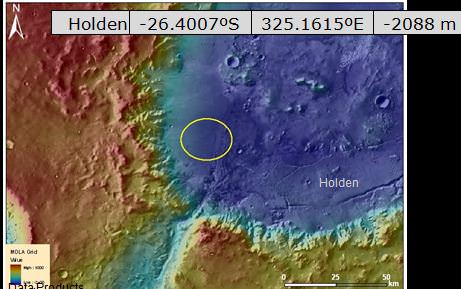
Holden Crater is the smoothest and flattest of the four choices. Southeast of the landing ellipse is an area of minerals that look enticing.
“There are mega breccias – rocks that were thrown up in giant impacts in the earliest days of Mars, so we could study those as well at Holden Crater,” Golombek. “But we’d have to drive pretty far to get there. There are also deposits that were certainly deposited in lake or a relatively quiet fluvial setting.”
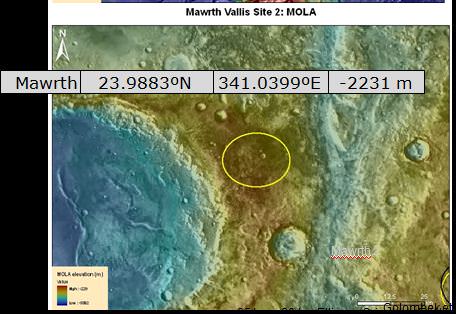
Mawrth Vallis holds complex mineralogy and has some of the oldest and longest sequence of rocks among the four sites and has phyllosilicate-bearing stratigraphy within the landing ellipse. Phyllosilicates, or sheet silicates, are an important group of minerals that includes water-bearing and clay minerals and are an important constituent of sedimentary rocks, which can tell the scientists much about Mars’ past.
Golombek praised the Mars Reconnaissance Orbiter mission for providing a extraordinary amount of data to allow the science team to make the best choice.
“The amount of data we have beforehand is unprecedented in Mars exploration,” he said, “with HiRISE(High Resolution Imaging Science Experiment camera) images at 25 cm per pixel, so we can see one meter-size boulders directly on the surface and we have almost complete coverage of the landing ellipses. CRISM (Compact Reconnaissance Imaging Spectrometer for Mars) provides visible and near infrared data to show minearology. The coverage we have is just spectacular.”

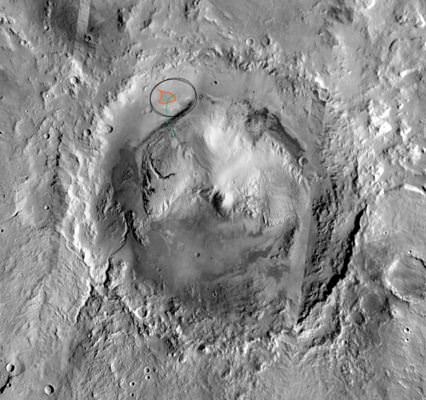
I would still like to see a lander explore Hellas Planitia.
Certainly an interesting place well within the Curiosity stated landing capability (< 45 deg S/N; < +1 km height).
Old? Check: "The basin is thought to have been formed during the Late Heavy Bombardment period of the Solar System, approximately 4.1 to 3.8 billion years ago, when a large asteroid hit the surface." [Wikipedia]
Water? Check: "Some of the low elevation outflow channels extend into Hellas from the volcanic Hadriacus Mons complex to the northeast, two of which Mars Orbiter Camera images show contain gullies: Dao Vallis and Reull Vallis. These gullies are also low enough for liquid water to be transient around Martian noon, if the temperature would rise above 0 Celsius."
Unique features (but see my previous comment)? Check: "The depth of the crater (7152-meters[6] (23,000 ft) below the standard topographic datum of Mars) explains the atmospheric pressure at the bottom: 1,155 Pa[6] (11.55 mbar, 0.17 psi, or 0.01 atm). This is 89% higher than the pressure at the topographical datum (610 Pa, or 6.1 mbar or 0.09 psi) and above the triple point of water, suggesting that the liquid phase would be transient (would evaporate over time) if the temperature would rise above 0 °C (32 °F).[7]"
It also means the impactor dug deep in the crust, potentially exposing unique material.
"Radar images by the Mars Reconnaissance Orbiter (MRO) spacecraft's SHARAD radar sounder suggest that features called Lobate debris aprons in three craters in the eastern region of Hellas Planitia are actually glaciers of water ice lying buried beneath layers of dirt and rock.[10]"
Hellas/Dao Vallis was on the list of prioritized landing sites after the 1st MSL workshop. So it had its chance.
It would be interesting to know why it failed. (Though there are ~ 50 more of those Qs to be asked for all the failed candidates. (O.o) ) Maybe it was too deep after all?
They make it very hard for an outsider to be disappointed with any of these exciting choices.
But they do surprise you, if this bit of “NASAology” is on the Martian quincunx (i.e. bronze coin money). Initially harkening to the zephyrs of Gale, I was lately coming over to the seemingly massive presentation of Mawrth Vallis as a unique opportunity: exposing an old (and long) rock sequence, combined with mineralogy.
“Gale is characteristic of a family of craters that were filled, buried and exhumed, and will provide insights into an important Martian process.”
Good point, this is the converse of unique so potentially more useful at early stages. To continue in the spirit [or is it with curiosity?] of NASAology, I wonder though if the drama, and ease of spelling [!], of Gale were contributing factors? =D
Mawrth Vallis would be the best choice if NASA wont follow the usual more conservative approach. Both visualy stunning and rich in science targets due to the most diversity of all landing sites in question.
Here is a nice teaser of what is awaiting us in Mawrth: http://www.youtube.com/watch?v=iUmJkb0PEns
no mention of thermal topography weighing in the decision.
is there no active thermal features anywhere on the surface?
can they plunk it into Albor Tholis so we can get some views?
I have hope that NASA would rectify that blunder a great choice for the Gale Crater landing Curiosity and I’ve read that the only scientific objectives presented here are a layered deposits that are located inside the crater in a mountain that is several kilometers in height making them unaffordable for Curiosity has not been designed for mountain climbing as well the origin of these deposits is not clear because they handle several hypotheses ranging from the action of water and wind to volcanic activity, these deposits are not achieved the mission would result in a costly failure for NASA since no other nearby targets that attract attention, instead choosing the Eberswalde crater would be examining deposits (phyllosilicates) and clay where there is a great certainty that they were deposited by water in the delta (with many channels) of a river is also fairly regular field without major declines ideal for the movement of Curiosity and finally NASA would be killing 2 birds with one stone Eberswalde crater since it is located just north of Holden Crater (they are almost adjacent, which would explore both)) the Holden crater might be speculated that the aciento of an ancient lake where rocks may have lots of evidence past life on Mars, I would therefore like the choice of the Eberswalde crater as it would be more fruitful from the scientific point of view and justify more than the expensive cost of this mission, greetings.
You really should look into the idea of punctuation. As it is, that comment reads as stream of consciousness. Though somewhat more ordered indicating it wasn’t meant as such.
And in fact I could parse this (I think):
‘[Gale has] a mountain that is several kilometers in height. Making [it] unaffordable for Curiosity, [which] has not been designed for mountain climbing.’
As a matter of fact, climbing rate doesn’t seem to be the problem.
I looked into a suggested lower mound traverse, which early on was characterized as, from the center of the landing ellipse, ~ 40 km long, ~ 1.2 km height gain, 1.3 Mars years. That out of a mound ~ 5.2 km high. This includes science targets along the way.
If the landing ellipse is flat, the remaining ~ 30 km gives a mean slope of a very modest 0.04. Everything else equal, it would take Curiosity ~ 5.5 Mars years to climb the mound. The RTG has a minimum life time of 14 years, which is ~ 7 Mars years.
What I can see Curiosity can climb the whole mound, if it gets the chance. The problem seems to be the mound should be steeper!